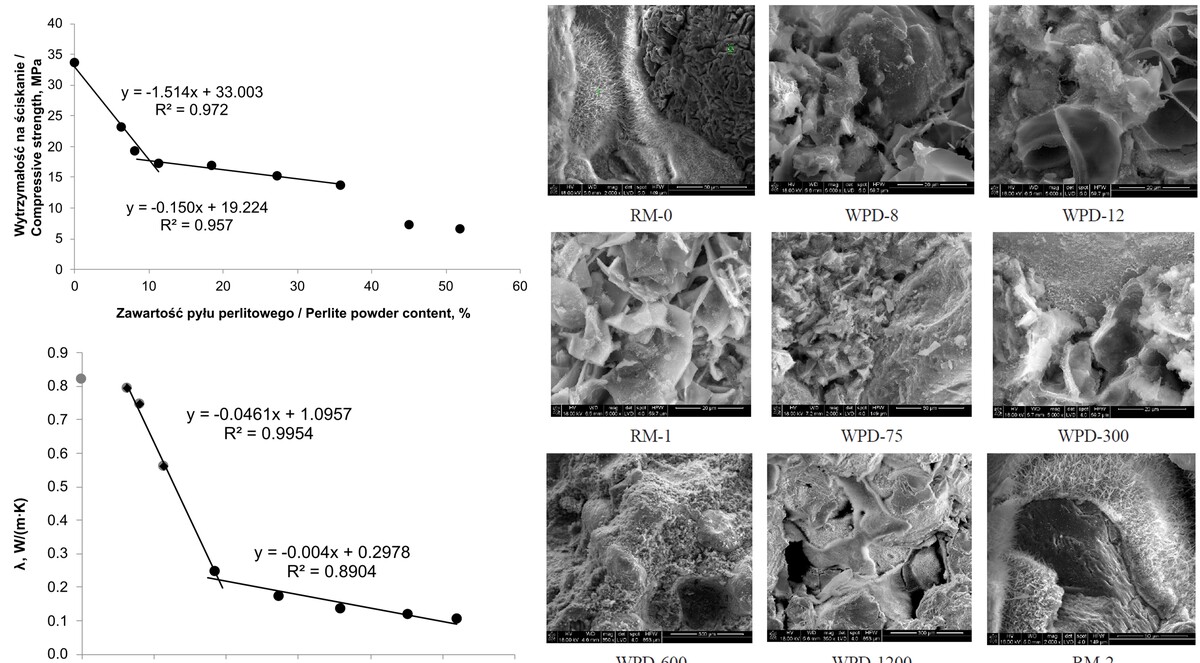The influence of waste perlite dust on the thermal properties of silicate materials
1
AGH University of Krakow, Kraków, Poland
Submission date: 2025-05-16
Final revision date: 2025-09-16
Acceptance date: 2025-09-26
Publication date: 2025-09-29
Cement Wapno Beton 30(2) 92-109 (2025)
KEYWORDS
waste perlite dustsilicate materialsautoclaved sand-perlite-lime materialsthermal conductivity coefficientthermal insulation materials
ABSTRACT
The research concept assumed the development of silicate materials with better thermal properties than traditional sand-lime brick. This effect was to be achieved by completely or partially replacing the traditional quartz sand aggregate with microaggregate in the form of waste perlite dust [WPD]. The aim of the first stage of the research was utilization assessment of waste perlite dust as a substitute for quartz sand in mixtures with variable amounts of binder and microaggregate, with CaO/SiO2 molar ratios of 0.09 and 0.17. The resulting autoclaved silicate brick materials had favorable thermal insulation properties, similar to those of aerated concrete. Their low compressive strength necessitates the classification of these materials as thermal insulation materials, rather than structural materials. In the second stage of the research, an attempt was made to increase the strength of the composites by introducing a high-strength aggregate: quartz sand. These materials were obtained from masses with varying amounts of raw material mixtures intended for the production of lime-perlite and lime-sand materials. Both types of mixtures were prepared at a CaO/SiO2 molar ratio of 0.09. The characteristics of these materials indicate that with appropriately selected quantitative proportions of waste perlite dust to quartz sand, an autoclaved material equivalent to silicate brick can be obtained. This material, with an acceptable reduction in strength properties to a level that guarantees the preservation of structural properties [minimum 5 MPa], is characterized by a relatively low thermal conductivity coefficient λ [in the range of 0.11–0.25 W/(m∙K)].
REFERENCES (29)
1.
R. Pampuch, ABC materiałów ceramicznych, Akademia Górniczo-Hutnicza, Kraków, 2013.
2.
R. Pampuch, Budowa i właściwości materiałów ceramicznych, Wydawnictwa AGH, Kraków, 1995.
3.
W. Płoński, J.A. Pogorzelski, Fizyka budowli. Zasady projektowania przegród budowlanych w zakresie cieplno-wilgotnościowym, Arkady, Warszawa, 1979.
4.
J. Małolepszy i in., Podstawy technologii materiałów budowlanych i metody badań, Rozdział 5: Materiały termoizolacyjne, s. 120–136, Wydawnictwa AGH, Wydanie I (zaktualizowane i poszerzone), Kraków, 2013.
5.
B. Stefańczyk praca zbiorowa, Budownictwo ogólne, tom 1: Materiały i wyroby budowlane, Wyd. Arkady, Warszawa, 2005.
6.
R. Pampuch, Materiały i technologie ceramiczne od wczoraj do dzisiaj, AGH, Kraków, 2013.
7.
R. Pampuch, Pomaga żyć. Ceramika wczoraj i dziś, Wyd. Naukowe Akapit, Kraków, 2008.
8.
M. Szafran, Makroskopowe i mikroskopowe aspekty projektowania ceramicznych tworzyw porowatych, Prace Naukowe Politechniki Warszawskiej. Chemia, Oficyna Wydawnicza Politechniki Warszawskiej, z. 63, Warszawa, 2000.
9.
G. Zapotoczna-Sytek, B. Svetozar, Autoklawizowany beton komórkowy. Technologie, właściwości, zastosowanie, Wyd. Naukowe. PWN, Warszawa, 2022.
10.
St. Wolfke, Technologia wyrobów wapienno-piaskowych, Wydawnictwo Arkady, Warszawa, 1986.
11.
J. Dobek, Cegła wapienno-piaskowa. Surowce i proces technologiczny, Wydawnictwo Budow¬nictwo i Architektura, Warszawa, 1955.
12.
P.D. Rademaker, V. Reiman, Autoclaving calcium silicate bricks, Zement-Kalk-Gips, 47, 11 (1994).
13.
J. Małolepszy i in., Podstawy technologii materiałów budowlanych i metody badań, Rozdział IV: Autoklawizowane materiały budowlane, Wydanie II poprawione i uzupełnione, Kraków, 2022.
14.
W. Skalmowski, Chemia materiałów budowlanych, Wydawnictwo Arkady, Warszawa, 1971.
15.
M. Handke, Krystalochemia krzemianów, Wydanie drugie poprawione, Uczelniane Wydawnictwa Naukowo-Dydaktyczne, Kraków, 2008.
16.
Z. Pytel, W. Pichór, Patent PL 230095 – Sposób wytwarzania materiału budowlanego o właściwościach termoizolacyjnych.
17.
M. Kępniak, P. Prochoń, W. Piątkiewicz, Cem. Wapno Beton 28(3), 186-193 (2023). https://doi.org/10.32047/CWB.2....
18.
A. Łagosz, D. Olszowski, W. Pichór, Ł. Kotwica, Quantitative determination of processed waste expanded perlite performance as a supplementary cementitious material in low emission blended cement composites. J. Build. Eng. 40, 102335 (2021). https://doi.org/10.1016/j.jobe....
19.
E. Kapeluszna, Ł. Kotwica, W. Nocuń-Wczelik, Comparison of the effect of ground waste expanded perlite and silica fume on the hydration of cements with various tricalcium aluminate content – Comprehensive analysis. Constr. Build. Mater. 303, 124434 (2021). https://doi.org/10.1016/j.conb....
20.
A. Różycka, W. Pichór, Effect of perlite waste addition on the properties of autoclaved aerated concrete. Constr. Build. Mater. 120, 65-71 (2016). https://doi.org/10.1016/j.conb....
21.
Ł. Kotwica, W. Pichór, E. Kapeluszna, A. Różycka, Utilization of waste expanded perlite as new effective supplementary cementitious material. J. Clean. Prod. 140, 1344-1352 (2017). https://doi.org/10.1016/j.jcle....
22.
A. Bielański, Chemia ogólna i nieorganiczna, Państwowe Wydawnictwo Naukowe, Warszawa, 1970.
24.
H.F.W. Taylor, The calcium silicate hydrates, Chapter 5 of The Chemistry of Cements, Vol. 1, Academic Press, London and New York, 1964.
25.
W. Pichór, Ultralekkie wypełniacze mineralne. Właściwości, modyfikacja, zastosowanie. Ceramika, Polski Biuletyn Ceramiczny, 122, Kraków, 2016.
26.
PN-EN 771-2: 2004 – Wymagania dotyczące elementów murowych. Część 2: Elementy murowe silikatowe.
27.
PN-EN 772-1: 2001 - Metody badań elementów murowych. Część 1: Określenie wytrzymałości na ściskanie.
28.
PN-EN 772-13: 2001 - Metody badań elementów murowych. Część 13: Określenie gęstości netto i gęstości brutto elementów murowych w stanie suchym.
We process personal data collected when visiting the website. The function of obtaining information about users and their behavior is carried out by voluntarily entered information in forms and saving cookies in end devices. Data, including cookies, are used to provide services, improve the user experience and to analyze the traffic in accordance with the Privacy policy. Data are also collected and processed by Google Analytics tool (more).
You can change cookies settings in your browser. Restricted use of cookies in the browser configuration may affect some functionalities of the website.
You can change cookies settings in your browser. Restricted use of cookies in the browser configuration may affect some functionalities of the website.




